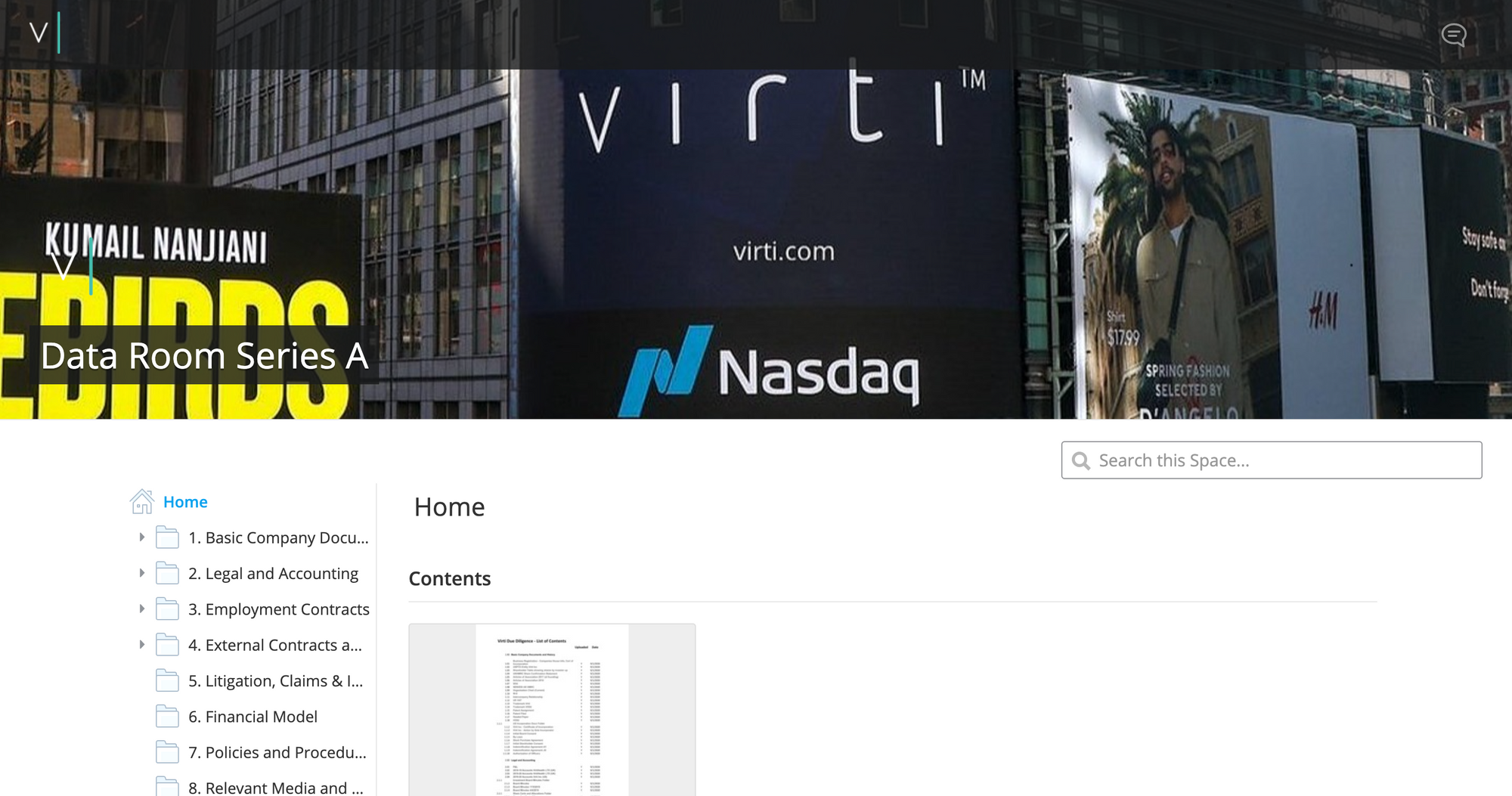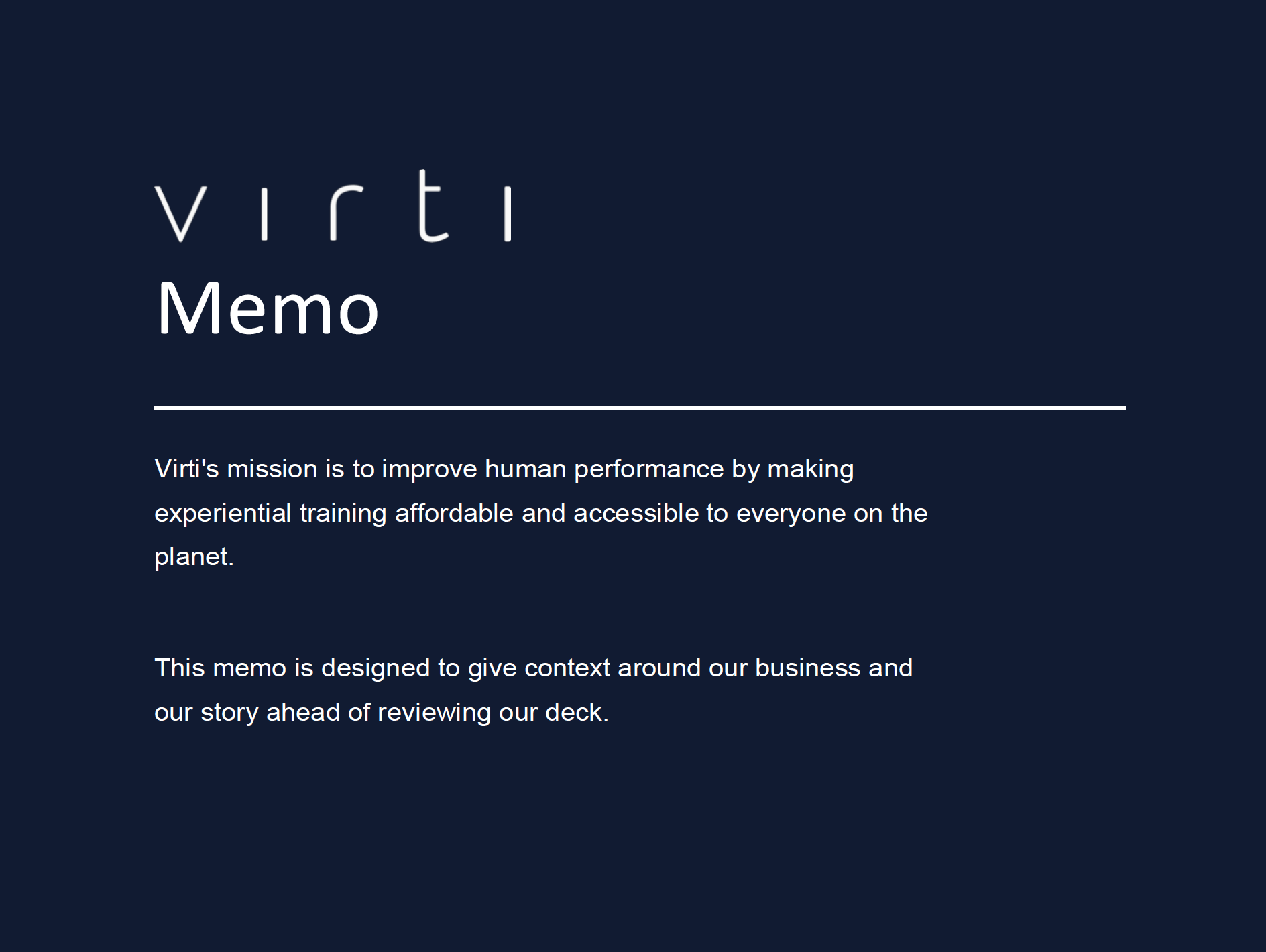How I Raised A $10 Series A (Deck and Process)
In this post I breakdown how I raised $10M for my company Virti and share our pitch deck and investment process to help you do the same.
When I set out to raise our $10M Series A investment round at Virti there were few examples of how to compose an investment deck for a deep technology company and there were also minimal explanations of how to efficiently run an investment process and certainly minimal guidance for doing so during a global pandemic when in-person meetings weren't possible.
Our Series A closed pretty quickly and I was asked about our investment process by a number of tech journalists and peers and so in the spirit of knowledge-sharing and transparency I thought I would go into detail regarding the process where I came at it with minimal example materials or stepwise guides.
Hopefully this article will help you to raise your own Series A round, save you valuable founder/CEO time and help get you back to the most important thing; building an amazing product-led and mission-driven business.
When To Raise Series A
In September of 2020 Virti had grown by almost 1000% in revenue, with low churn and an aggressive product roadmap. On the back of some press where we were featured on the Nasdaq Tower in Times Square a number of venture capital firms began to reach out to us. At the same time I was feeling pretty good about company growth and, while our financial model had a Series A raise pencilled in for Summer 2021 we had already exceeded all our goals set at our seed round and I felt the time was right to accelerate development and bring in some senior personnel where I as a solo founder had been wearing lots of hats.
I discussed the plan with our seed investors, board and advisors and everyone agreed it was a great time to raise using the year end as a hard close for meetings and the first 3 months of 2021 to wrap DD and legals. To summarise, the three criteria I used to decide on when to raise were:
- Business growth and revenue
- Met or exceeded targets set at seed
- Need for additional resources to grow faster
In terms of revenue I was more interested in growth rather than actual number. When researching average revenues of Series A companies data from Y-Combinator noted that these can vary widely:
We’ve seen A's happen for SaaS companies with ARR between $200k and $9m with plenty of companies failing all along that range. Clearly VCs don’t care that much about this rule.
At the time of raising our series A we had 14 employees and I wanted to run a process which got me back to working on the business rather than spending too long raising capital. 21 days after starting the process we had 5 term sheets which was fairly crazy and meant we then had to think about which investors to choose from, putting us in a position of abundance.
Series A Preparation
I tend to make decisions and manage any project using a simple system of research, plan, execute and iterate based on data. I spent a solid week preparing for raising our series A and my goals for the preparation phase were:
- To prep the team for raising funds
- To construct a pitch deck that told a compelling story and which displayed key metrics
- To update our data room for series A due diligence
- To create email templates and a playbook
Prepping The Team For Life Without You
After deciding to raise capital I discussed with the team and stepped out of my day-to-day duties to concentrate fully on fundraising. Fundraising can be all-encompassing and take anywhere from 2 weeks to 4 months. For early stage companies raising money is the job of the CEO and I planned for it to be my sole, full-time focus. I prepped the team for life without me, setup regular check-ins and ensured we had a robust hiring plan for when the funding round closed.
Pitch Deck Story and Metrics
As a surgeon I'm very comfortable talking about metrics, numbers and practicalities but was less good at "Blue Ocean" story-telling. I therefore spent most of my prep time working on the deck, gathering data, making projections and constantly iterating based on feedback from peers, existing investors and investors on our updates list who were friendly. We'll touch on the deck shortly but the best advice I was given was to tell a story of how the business is going to win such that investors will be scared they are missing out. Generating FOMO combined with solid growth metrics will mean that investors are less likely to pass you up.
Data Room
After creating the the pitch deck I ensured that our data room was robust so that when investors wanted to review it I could instantly grant access.

I iterated upon our seed data room with the latest information pertinent to the company covering key business information, contracts, legal, financial model and more. I chose to use DocSend which allows for spaces to be created which can be shared with investors via individual tracking links. DocSend also allows for electronic NDAs to be incorporated and for expiry dates to be set. This essentially meant that the data room looked nice rather than a simple folder structure; I could see how interested investors were following access being granted by link tracking and the contents were secure and access automated to save me time and any concern when sharing sensitive information.
Email Templates and Playbook
Finally I created a mini-CRM in an excel document and made a list of the 60 key investors I wanted to connect with. This was a mix of investors already on our investor updates list together with investors I would need to approach cold or via warm intro. I then created a schedule for when I would make initial approaches, have coffee meetings and follow-on partner meetings to set myself goals and a timeframe to keep the process tight. To help save time I also automated follow-up emails using templates with links to the pitch deck and data room so that I could send these immediately following a meeting. I'm a huge stickler for being fast and responsive and a key component of this is being prepared.
We'll touch on the CRM and playbook when we look at the process itself but let's first look at the pitch deck and memo we used.
Series A Materials
When creating the series A pitch deck I tried to follow some key pieces of advice I had been given:
- I kept the Series A deck concise (15 slides in total)
- I limited each slide to a single concept
- I allowed data to tell a story
- I kept concepts simple and left room for deeper questions
- I kept the slides visual and light on text
- I followed a standard format of: problem, market-size, solution, traction, team, vision and use of funds
I cut out lots of information I wanted to put into the deck and prepped a concise pitch to run through in 10-minutes at coffee meetings and a longer pitch using an appendix for questions and second and third-stage meetings. Y-Combinator gives a nice overview of how to approach building a Series A deck if you are after further information.
The Series A Memo

In addition to the deck I also created a longer written document of 3 A4 pages which covered each slide in detail and helped to flesh out what I had spoken about at the pitch. Memos can help with storytelling as they are a longer written document and the memo was seen as helpful by investors and provided supplementary information where the deck was more visual. You can think of this as a mini-brochure covering key business information and expanding on your slides. Memos are standalone, can be read without the pitch deck and align to the internal memos used by VCs to communicate the investment opportunity. Usually the investor taking your company forward will write a memo laying out the case for the investment so anything that makes his or her life easier is likely to be well-received.
The Series A Pitch
I practised my pitch religiously and I timed myself. I practised by myself and with anyone who would listen, taking notes on any feedback and pressing people to see if they understood the business and were excited by it. If not I simplified, iterated and repeated.
Deck Feedback
The main positive feedback from investors on the deck and memo was that the vision was clear and that we had been capital efficient in a short space of time with a small team.
The main negative feedback was that we could have had more data on marketing and growth channels and more data on opportunities outside of healthcare.
One thing I would add to the deck going forward is a summary slide as page 1 or 2 which summarises key metrics such as ARR, MoM Growth, YoY Growth, NPS Score and Sales Rep Payback Period to grab attention up front as a headlines page.
The Series A Process
Having created and iterated the Series A materials and set a schedule with my list of well-researched investors I then followed a set strategy to be as efficient as possible with my time.
Investor Intros
We already had an investor updates mailing list I had built up over a 4 month period prior to raising (which is something I highly recommend doing) which allowed for quick meetings and we had had investors reaching out to us on the back of some press. This got us around 15 investor meetings. For anyone I didn't have a direct connection to I looked for warm intros from investee companies in the VC's portfolio, from other investors and from lawyers and accountants in our network. This got us to around 30 meetings. I didn't use cold outreach and opted for warm intros only. I had created a template email which anyone intro'ing us could use to make things as easy as possible for them and to reduce any obstacles.
Meetings and Schedule
Rather than pitching to investors one after another I did my best to run a parallel process where I had as many coffee meetings as possible in weeks one and two and then pushed for quick follow-up meetings for investors who were interested and were a fit for us. While a parallel process is very meeting-heavy (I was having around 5+ meetings per day on average due to zoom meetings being more accessible than in-person) a parallel process is also very time efficient.
At the end of each meeting I gauged interest and pushed for a follow-up meeting and next steps ensuring I understood the investor's timeframe and thesis to make sure they aligned to our own. After each meeting I noted down any questions that were asked and ensured I had solid answers for each should they come up again. I used a standard follow-up template which included a secure DocSend link to the deck and memo and some collateral information from the website including a product video which I shared immediately after the end of the meeting.
Data, Follow-Up and Funnels
After each meeting I noted down the date in my excel CRM, the date of the next booked meeting, any key notes and, if we were rejected, the reasons we weren't a fit. Using DocSend I was able to see when and for how long investors reviewed the investment materials which helped to gauge interest and to also understand how they operated. Following my own advice on rejection I didn't let any knock-backs phase me, thanked investors and continued on with other leads. If investors didn't follow-up within 48hrs after the coffee meetings I emailed over a non-chasing business update to offer value and a friendly reminder and optimised for the investors who responded fast as being fast is part of our company culture.
As with any funnel by weeks 2 and 3 we were down to 20 investors who wanted multi-partner second and third stage meetings. Some investors moved very quickly with days in between meetings and others were slower. As I had prepared our data room, had answers ready to go for any questions asked over email I was able to respond quickly and therefore the best investors could also move quickly.
In week three we were offered our first term sheet and we ended up with five of various terms and offers.
Making a Decision
By week 4 I was in the unexpected situation of having to select a lead investor. At the beginning of the process I had some biases about the type of investor I thought I wanted, however, after thinking deeply and reflecting on the investor meetings the key criteria I felt were important were:
- The investor had to be passionate about our mission
- The investor had to understand the technology
- The investor had to have good communication skills and be founder-friendly both in term sheet terms and attitude
- The investor had to have strong feedback from their own portfolio companies and from the wider investment community
The first three points were apparent from conversations throughout the process and from the term sheets offered. For the fourth point I opted to do our own due diligence and speak with portfolio companies and other investors. I took my time doing this as a Series A lead investor will likely be on your board and effectively part of your company and your life for a long period of time.
On the point of terms sheets my advice is to keep things vanilla and founder-friendly. Key elements such as preference rights, board seats and board majority should be friendly to the founder and not weighted towards the VC. Equally do not try to over-optimise or haggle around things like valuation (which should have been discussed during the meetings), focus on closing the round and getting back to business.
Closing
We were delighted to accept a term sheet from our lead investor (who by the way was one of the few investors who asked about our company mission and took real interest in the team). Following term sheet acceptance you move into due diligence and legals. As we had been open with our data room we had everything prepped and good to go and then it was a matter of handing over to lawyers and signing documents.
What I Learned
- Fundraising necessitates all of your founder-time and consequently expect a dip in productivity if you are in a small company while you focus on fundraising
- Build an investor updates mailing list proactively 12-6 months before you plan to raise. This will help get you those first meetings
- Zoom calls are extremely tiring especially when speaking with people in different timezones. Don't take long meetings at an early stage and set boundaries with your time
- Legals and DD after accepting a term sheet can be long and expensive, accept that this is part of the process and try to get back to your business as quickly as possible

